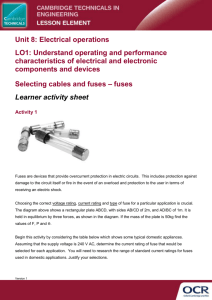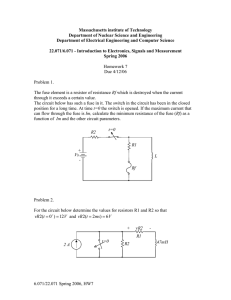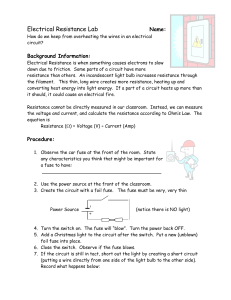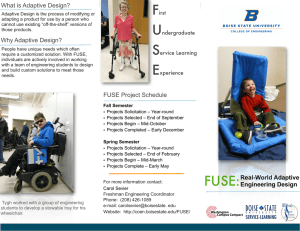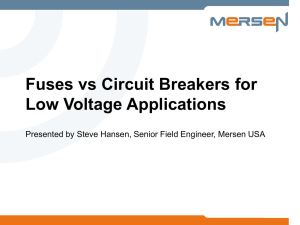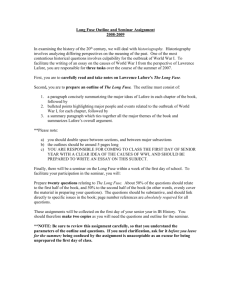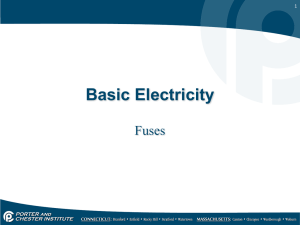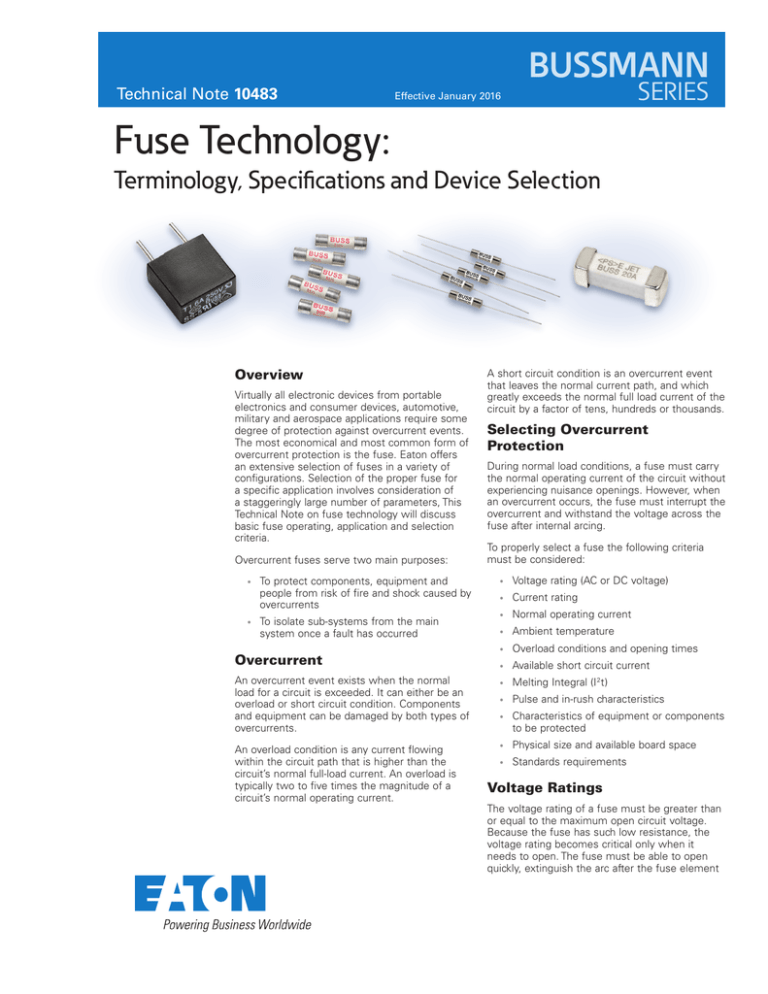
Technical Note 10483
BUSSMANN
SERIES
Effective January 2016
Fuse Technology:
Terminology, Specifications and Device Selection
Overview
Virtually all electronic devices from portable
electronics and consumer devices, automotive,
military and aerospace applications require some
degree of protection against overcurrent events.
The most economical and most common form of
overcurrent protection is the fuse. Eaton offers
an extensive selection of fuses in a variety of
configurations. Selection of the proper fuse for
a specific application involves consideration of
a staggeringly large number of parameters, This
Technical Note on fuse technology will discuss
basic fuse operating, application and selection
criteria.
Overcurrent fuses serve two main purposes:
•
•
To protect components, equipment and
people from risk of fire and shock caused by
overcurrents
To isolate sub-systems from the main
system once a fault has occurred
Overcurrent
An overcurrent event exists when the normal
load for a circuit is exceeded. It can either be an
overload or short circuit condition. Components
and equipment can be damaged by both types of
overcurrents.
An overload condition is any current flowing
within the circuit path that is higher than the
circuit’s normal full-load current. An overload is
typically two to five times the magnitude of a
circuit’s normal operating current.
A short circuit condition is an overcurrent event
that leaves the normal current path, and which
greatly exceeds the normal full load current of the
circuit by a factor of tens, hundreds or thousands.
Selecting Overcurrent
Protection
During normal load conditions, a fuse must carry
the normal operating current of the circuit without
experiencing nuisance openings. However, when
an overcurrent occurs, the fuse must interrupt the
overcurrent and withstand the voltage across the
fuse after internal arcing.
To properly select a fuse the following criteria
must be considered:
•
Voltage rating (AC or DC voltage)
•
Current rating
•
Normal operating current
•
Ambient temperature
•
Overload conditions and opening times
•
Available short circuit current
•
Melting Integral (I 2t)
•
Pulse and in-rush characteristics
•
Characteristics of equipment or components
to be protected
•
Physical size and available board space
•
Standards requirements
Voltage Ratings
The voltage rating of a fuse must be greater than
or equal to the maximum open circuit voltage.
Because the fuse has such low resistance, the
voltage rating becomes critical only when it
needs to open. The fuse must be able to open
quickly, extinguish the arc after the fuse element
Technical Note 10483
Fuse Technology:
Terminology, Specifications and Device Selection
Effective January 2016
has melted, and prevent the system’s open-circuit voltage from
re-striking across the open fuse element.
Current Ratings
The current rating of a fuse identifies its current-carrying capacity based on a controlled set of test conditions. Each fuse is
marked with its current rating. This rating can be identified with a
numeric, alpha or color code mark. Marking codes can be found
in each product’s data sheet.
Normal Operating Current
The normal operating current of a circuit is the level of current
drawn (in RMS or DC amperes) after it has been energized and is
operating under normal conditions. An operating current of 80%
or less of rated current is recommended for operation at 25°C
to avoid nuisance openings. For example, a fuse with a current
rating of 1A is usually not recommended in circuits with normal
operating currents of more than 800mA. Further derating is
required at elevated ambient temperatures.
Ambient Temperature
Ambient temperature is the temperature of the air immediately
surrounding the fuse and is not necessarily room temperature.
All electrical characteristics of a fuse are rated and validated at
an ambient temperature of 25°C. Both higher and lower ambient
temperatures will affect a fuse’s opening and current carrying
characteristics. This effect is demonstrated in temperature derating curves.
Overload Conditions and Opening Times
Specific attention must be given to first overload operating
points. For fuses, the first overload point is usually between
200% to 300% of rated current, with 400% typically being the
first overload point for circuit protectors.
Breaking Capacity / Interrupting Rating
A fuse must be able to open the circuit under a short circuit
condition without endangering its surroundings. The breaking
capacity or interrupting rating of a protective device is the
maximum available current, at rated voltage, that the device can
safely open without rupturing. The breaking capacity or interrupting rating of a fuse must be equal to or greater than the available
short circuit current of the circuit.
Melting Integral
The melting integral of a fuse, commonly referred to as I2t, is
the thermal energy required to melt a specific fuse element.
The construction, materials and cross sectional area of the fuse
element will determine this value. Each fuse series and ampere
rating utilize different materials and element configurations;
therefore, it is necessary to determine the I2t value for each
fuse. Tests to determine the I2t of a fuse are the rated current
with a time constant of less than 50 microseconds in a dc test
circuit. High-speed oscilloscopes and integral programs are used
to measure very accurate I2t values. I2t data is depicted in a time
vs. current graph (Figure 1).
The melting I2t of a fuse is one of the values used to assist circuit
designers when selecting and properly sizing a fuse in a specific
application. It can be compared to the thermal energy created by
transient surge currents in a circuit.
2
Figure 1. Time vs. Current Curves for Model S505SCH timedelay, high I 2t fuse
Time vs. Current Curves
A time current curve represents the relationship between a
fuse’s melting or clearing time and the magnitude of RMS or
DC current. The characteristics represented on most published
graphs usually indicate a fuse’s average melting time when
subjected to a certain level of current. The curves will typically
demonstrate the ability to carry 100% of rated current. They also
represent the fuse’s ability to open within the maximum opening
time at designated overload points (typically 135% to 300% of
the fuse rating).
Time vs. current curves offer a useful design aid for engineers
specifying a fuse type or rating for an application. It is, however,
recommended that fuse samples be tested in the actual application to verify performance.
Surge and Pulse Current Characteristics
Transient surge or pulse currents are used to describe wave
shapes that result from any startup, inrush, surge or transient
currents in a circuit. The pulse currents are normal for some applications. It is therefore important to size the fuse properly to allow
these pulses to pass without nuisance openings or degradation
of the fuse element. The fuse must then open within the limits
specified by UL and CSA standards if the overload condition
EATON www.eaton.com/electronics
Technical Note 10483
Effective January 2016
continues. The ability to resist surges is a function of the fuse
design and/or classification relative to the surge pulse, duration
frequency and so on.
Pulse currents can produce thermal energy that may not be
large enough to open the fuse but could possibly cause element
fatigue and decrease the life of the fuse. To properly size a fuse
and determine its surge withstand capability, the circuit’s pulse
energy should be determined and compared to the time current
curve and I2t rating of the fuse. The fuse’s melting I2t value must
be greater than or equal to the pulse I2t multiplied by a pulse
factor.
Fuse Technology:
Terminology, Specifications and Device Selection
Fuse Withstand Capability
A fuse’s capability to withstand a surge pulse without causing
thermal stress to the fuse element, which may result in nuisance
openings, can be determined once the circuit’s pulse I2t is calculated. A circuit designer needs to properly size the fuse so that
the fuse’s melting I2t value is greater than or equal to the pulse
I2t multiplied by a pulse factor Fp (I2t fuse ≥ I2t pulse x Fp).
The pulse factor is dependent on the construction of the fuse
element. A wire-in-air constructed fuse element (e.g., ferrule
fuses, 6125 and 1025 series) will be affected by the number and
frequency of surge pulses the fuse is subjected to over the lifetime of the device. This construction design utilizes low-meltingpoint metals plated or deposited on the main element material
to cause an “M” effect. If the fuse is sized improperly, low-level
pulse currents may cause the low-melting-point metals to alloy to
the element without completely opening the element.
A series of pulse currents will eventually create enough heat to
shift resistance or even permanently open the fuse. It is important, therefore, to take into account the number of pulse currents
to which the fuse will be subjected.
Solid matrix fuses (e.g., 0603FA or 3216FF sized surface mount
fuses) do not currently use an “M” effect for the element
construction. The element will only then be affected by the
thermal energy of each pulse, and it will not normally degrade as
a result of the number or frequency of pulses.
Table 1 can be used to determine pulse factor (Fp). For example,
a pulse current with an I 2t of 0.0823 and a pulse factor, Fp=1.25
would require the selection of a fuse to have a melting I 2t greater
than or equal to 0.1029.
•
Melting I2t fuse ≥ I2t pulse x Fp
•
Melting I2t fuse ≥ 0.0823 x 1.25
•
Melting I2t fuse ≥ 0.1029
It is important to note the melting of I 2t values of the fuse and
pulse current that are compared must be calculated or tested at
the same test conditions; most importantly the magnitude of the
peak current must be the same. For example, if the pulse’s peak
current is 15A, then the fuse’s melting I 2t must be calculated at
15A as well to fully understand its electrical characteristics at that
magnitude of current.
Solid Matrix Construction
Wire-in-Air Construction
Figure 2. Pulse wave shapes and I2t calculations
The peak current and decay time define the pulse current characteristic or waveform. Pulses can generate different waveform
shapes, which determine the formula used to calculate the pulse
energy or I2t. Figure 2 shows how to select the appropriate waveform and its corresponding pulse I2t calculation.
EATON www.eaton.com/electronics
Table 1. Pulse Factor, Fp
3
Fuse Technology:
Terminology, Specifications and Device Selection
Technical Note 10483
Effective January 2016
Physical Sizes
There are numerous physical sizes of electronic fuses, including subminiature fuses (Table 2). The most common ferrule
designs are 5x15mm, 5x20mm and 6.3x32mm (1/4” x 1 1/4”).
Subminiature fuses are often used when board space is limited.
For applications of this type, there are through-hole and surface
mount devices available. Standard package sizes for surface
mount fuses are 0402 (1005), 0603 (1608), 1206 (3216), 6125,
and 1025. These sizes are standard throughout the electronic
industry. Through-hole axial and radial leaded products allow
fuses to be PCB mounted. Standard ferrule fuses fitted with
leads can also be mounted in this way.
Eaton Electronics
Product Selection Tools
PARAMETRIC SEARCH
Drill down into the Eaton
Electronics product database
to find the right part for your
application.
CROSS REFERENCE
Find a cross to a competitor’s
product or to an alternate Eaton
Electronics part number.
IC MATCHING
Table 2. Physical sizes of traditional
ferrule fuses
Find the Eaton Electronics parts
called out on IC manufacturers’
demo and evaluation boards.
Fuse Resistance
In most applications, the voltage drop across the fuse due to its
internal and contact resistance is negligible. There are, however,
certain critical applications where the fuse resistance must be
considered and it is important that the circuit designer understands the fuse characteristics in order to select the proper fuse.
Applications that are powered by low voltage batteries, typically
3V or less, and utilize fractional rated fuses with high resistance
may require special attention be given to the voltage drop across
the fuse.
Standards
North American UL/CSA and IEC standards require significantly
different time vs. current characteristics for overcurrent devices.
Typically the physical dimensions and materials used are similar;
however, fuses built to different standards are not interchangeable because their element melting and opening times will differ
when subjected to the same magnitude of current. It is therefore
important for circuit designers to consider that world standards
may require different fuses.
4
EATON www.eaton.com/electronics
Technical Note 10483
Effective January 2016
Fuse Technology:
Terminology, Specifications and Device Selection
Eaton Bussmann Series
Overcurrent Protection Products
CHIP™ Fuses
The patented Solid Matrix CHIP™ fuses provide reliable overcurrent protection to secondary circuits found in mobile phone handsets, battery packs, digital still cameras, portable devices, printers, notebook computers,
televisions, automotive instrument
panels, battery packs, and more. Its
excellent cycling characteristics, small
footprint, and SMD package provide
the most effective, reliable overcurrent protection solution for today’s
- and tomorrow’s - technologies.
BRICK™ Fuses
The patented BRICK™ fuses provide the excellent inrush
withstand capabilities in a space saving SMD
package needed in many of today’s more
demanding applications such as power
supplies, base stations, televisions,
computers, white goods, and motor
control circuits among others.
Radial Leaded Fuses
IEC & UL Electronic Fuses
In addition to SMD and Thru-Hole Device Fuses, Eaton offers a
offers a full range of Bussmann Series traditional electronic fuses
designed to IEC standards (5mm product line) and UL standards
(1/4” product line). Both product
lines offer a cost-efficient
overcurrent protection
solution for a wide
range of applications
including power
supplies, white goods,
motor control equipment, and set-top
boxes.
Fuse Accessories
Eaton has an extensive product offering of Bussmann Series
fuse accessories which include PCB
clips for 5mm, 1/4”diameter,
13/32” diameter and blade
style fuses, panel
mount holders, in-line
holders, water
proof holders and
blocks.
Eaton offers Bussmann Series space-saving radial leaded fuses
for the global market to provide cost-effective primary circuit
protection in space constrained applications
such as power adapters, televisions,
handheld consumer prodycts, white
goods, and more.
EATON www.eaton.com/electronics
5
Technical Note 10483
Fuse Technology:
Terminology, Specifications and Device Selection
Effective January 2016
GLOSSARY
Ampere Squared Seconds I2t
Overcurrent
The melting, arcing, or clearing integral of a fuse, termed I2t,
is the thermal energy required to melt, arc or clear a specific
current. It can be expressed as melting I2t, arcing I2t or the sum
of them, clearing I2t.
A condition that exists in an electrical circuit when the normal
load current is exceeded. Overcurrent conditions take on two
separate characteristics: overloads and short circuits.
Arcing Time
Overload
The amount of time from the instant the fuse link has melted
until the overcurrent is interrupted, or cleared.
Can be classified as an overcurrent condition that exceeds the
normal full-load current of circuit by two to five times its magnitude and stays within the normal current path.
Clearing Time
Resistive Load
The total time between the beginning of the overcurrent and
the final opening of the circuit at rated voltage by an overcurrent
protection device. Clearing time is the total of the melting time
and the arcing time.
An electrical load that is characterized by not drawing any
significant inrush current. When a resistive load is energized, the
current rises instantly to its steady-state value, without first rising
to a higher value.
CSA
RMS Current
The CSA Group works with businesses, organizations and code
authorities testing and certifying products.
The RMS (root mean square) value of any periodic current is
equal to the value of the direct current which, flowing through a
resistance, produces the same heating effect in the resistance as
does the periodic current.
Fast Acting Fuse
A fuse that opens very quickly during overload and short circuit
conditions. This type of fuse is not designed to withstand temporary overload currents associated with some electrical loads.
UL-listed or recognized fast acting fuses typically open within five
seconds, maximum, when subjected to 200% to 250% of its
rated current. IEC60127-4 has two categories of fast acting fuses:
• F = quick acting – opens 10x rated current within seconds
to 0.001 to 0.01 seconds
•
FF = very quick acting – opens 10x rated current in less than
0.001 seconds
Ferrule Fuse
A tubular fuse with a glass or ceramic body with metal end caps
which serve as termination points to clips used to facilitate insertion and removal.
Fuse
An overcurrent protection device with a fusible link that operates
and permanently opens the circuit in the event of an overcurrent
condition.
IEC
The International Electrotechnical Commission is the world’s
leading organization for the preparation and publication of
International Standards for all electrical, electronic and related
technologies.
6
Short Circuit
An overcurrent condition that leaves the normal current path and
greatly exceeds the normal full-load current of the circuit by a
factor of tens, hundreds, or thousands times.
Time Delay Fuse
A fuse with a built-in time delay that allows temporary and harmless inrush currents to pass without operating; and is designed to
open on sustained overloads and short circuits. UL-listed or recognized time delay fuses typically open in two minutes, maximum,
when subjected to 200% to 250% of rated current. IEC has two
categories of time delay fuses:
• T = time lag – opens 10x rated current within 0.01 seconds
to 0.1 seconds
•
TT = long time lag – opens 10x rated current within 0.1
seconds to 1 second
UL
UL is a global certification company that sets safety standards for
electrical commercial, industrial and consumer products.
Voltage rating
A maximum open circuit voltage at which a fuse can be used
while safely interrupting an overcurrent. Exceeding the voltage
rating of a fuse impairs its ability to safely clear an overload or
short circuit.
EATON www.eaton.com/electronics
Technical Note 10483
Effective January 2016
For technical support on any of EATON’s circuit protection
devices, please send your inquiry to
Fuse Technology:
Terminology, Specifications and Device Selection
FuseTech@eaton.com
CONTACT US
Americas
Asia-Pacific
CUSTOMER SERVICE AND INSIDE SALES
CUSTOMER SERVICE AND INSIDE SALES
Email: busselx@eaton.com
China
Email: elx.cn@eaton.com
Europe, Middle East, Africa
CUSTOMER SERVICE AND INSIDE SALES
Japan
Email: elx.jp@eaton.com
Email: elx.emea@eaton.com
Korea
Global Technical Support
Email: elx.kr@eaton.com
Magnetics: InductorTech@eaton.com
Circuit Protection: FuseTech@eaton.com
Supercapacitors: CapacitorTech@eaton.com
South East Asia
Email: elx.sea@eaton.com
Taiwan
Email: elx.tw@eaton.com
Eaton Electronics Division
1000 Eaton Boulevard
Cleveland, OH 44122
© 2016 Eaton
All Rights Reserved
Printed in USA
Publication No. 10483 - BU-MC16002
February 2016
Eaton is a registered trademark.
All other trademarks are property
of their respective owners.

